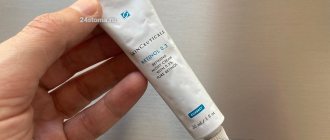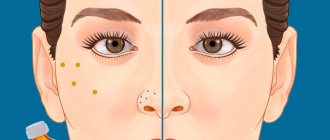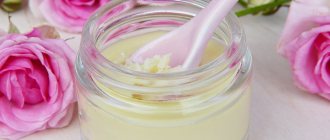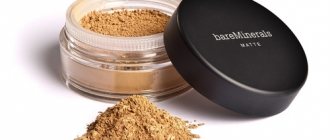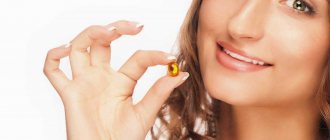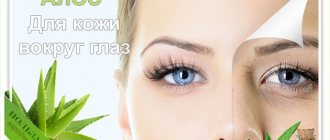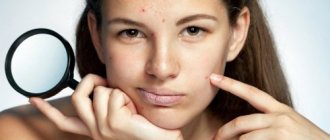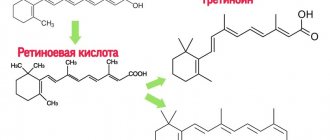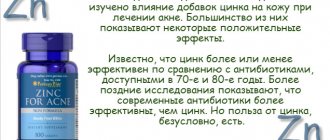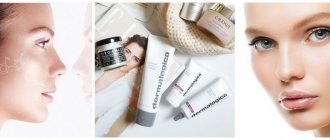From this article you will learn:
- Is retinoic ointment effective for wrinkles?
- retinoic ointment for wrinkles - reviews from doctors and patients.
Retinoic ointment belongs to the group of topical retinoids. Its main active ingredient is Isotretinoin (13-cis-retinoic acid), which is, in principle, one of the most effective forms of vitamin A for reducing the depth of wrinkles.
Thus, the effectiveness of Isotretinoin significantly exceeds the effects of using most other forms of vitamin A. Everyone has heard about cosmetics with retinol, retinaldehyde, as well as retinol acetate - all of these are forms of vitamin A that are different in effectiveness. Compared with isotretinoin, a stronger anti-aging effect on The skin is treated only with a retinoid such as Tretinoin (retinoic acid).
Retinoic ointment: composition and release forms
This is a homogeneous yellowish ointment in tubes of 10, 15, 20 or 35 g. Intended for external use only. Retinoic ointment can be produced with isotretinoin concentrations of 0.05% or 0.1%.
As excipients, the ointment contains: dibunol, butyloxyanisole, emulsion wax, petroleum jelly, glycerin, ethyl alcohol 95%, purified water - up to 100 g. Considering that this is an ointment (contains petroleum jelly and emulsion wax) - this drug after application will not be absorbed very well, leaving a greasy feeling on the skin.
Analysis of the composition - despite the fact that Isotretinoin itself reduces the secretion of the sebaceous glands (which allows the use of this active substance in the treatment of acne) - petroleum jelly and emulsion wax in the ointment will, on the contrary, clog the pores with a fatty substance.
Thus, it is not advisable to use the drug Retinoic ointment for acne and pimples, or if you have oily skin. For oily skin, it is optimal to use retinoids only in the form of gels, lotions or creams. Retinoic ointment is suitable only for people with dry skin.
Homemade face masks with retinol
To make such masks, you need to buy retinol in capsules or ampoules. This can be done either at a pharmacy or at a cosmetic store. Before the procedure, the skin must be thoroughly cleaned and exfoliated with a scrub. This will make her more susceptible to active substances.
Curd mask
Rejuvenates and smoothes the skin. Take 1 ampoule of palmitate, 7 g of thicker cream and 15 g of cottage cheese. Mix with a blender and spread over your face. Leave the mask on for half an hour and rinse off.
Mask with persimmon
Protects the skin from harmful influences and corrects the oval of the face. You need to mix puree from the pulp of 1 persimmon, 2 drops of vitamin A and 2 drops of vitamin A. Apply for 30 minutes and rinse with herbal decoction.
Retinoic ointment: price, analogues
Retinoic ointment for wrinkles - the average price will be 250-350 rubles per 10 g tube. Such a low price in comparison with other retinoid-based drugs is explained by the fact that the drug is produced in the form of a not very effective form (oily ointment), and not in the form lotion, cream or aqueous gel, which are a priori more effective forms of drugs for external use.
Analogues for the treatment of wrinkles –
On the Russian market, among products for external use, there are no analogues of retinoic ointment (based on the retinoid Isotretinoin) that could be used against wrinkles. But on the Internet you can buy Retin-A cream made in the USA (Fig. 4) - based on an even more effective retinoid than Isotretinoin. This gel contains the retinoid Tretinoin, and costs about $50 at the current rate (for a 20 g tube).
Analogues for the treatment of acne –
- Lotion "Retasol" (Fig. 5) - contains a 0.025% concentration of Isotretinoina that is weak enough to eliminate wrinkles, but is quite suitable for treating acne in people with oily skin.
- “Roaccutane”, “Acnecutane” (Fig. 6) are tablet forms of isotretinoin. It is these drugs that are most often prescribed abroad for the complex treatment of acne (blackheads and pimples). They are very, very effective, but they have a strict prescription and should be used only after consulting a dermatologist.
Retinoic ointment for wrinkles - reviews from dermatologists
Using drugs from the retinoid group to treat skin diseases, dermatologists found that the skin also became firmer, smoother, and the depth of wrinkles decreased. These effects were studied, and it turned out that Isotretinoin, which is part of the retinoic ointment, can significantly rejuvenate facial skin with long-term use.
Main effects of Isotretinoin –
- improves skin texture (by exfoliating dead skin cells),
- improves skin color,
- increases skin thickness and elasticity,
- reduces the secretion of sebaceous glands,
- stimulates the activity of fibroblasts in the dermal layer of the skin, which leads to stimulation of the production of collagen, elastin and hyaluronic acid. As a result, skin elasticity increases, the depth of wrinkles and fine lines on the face decreases.
Optimal concentration and timing of use of Isotretinoin to reduce wrinkles -
In the article devoted to Isotretinoin, we analyzed in detail all clinical studies that studied the optimal concentration and timing of isotretinoin use for the treatment of skin photoaging and reduction of wrinkle depth.
Conclusions from clinical studies - firstly, the optimal treatment period is at least 36 weeks. Secondly, the choice of concentration will depend on your goals: it can be either only the prevention of skin photoaging, or the need for significant changes in the skin (reducing the depth of wrinkles, increasing its thickness and elasticity).
If you only need to prevent photoaging, then it is best to use Retinoic ointment with a 0.05% concentration of Isotretinoin. Moreover, this must be done in combination with sunscreens that have a protection factor of at least SPF 30. As a result, you will get an improvement in skin color and texture, plus excellent prevention of wrinkles.
If your skin already has signs of photodamage, fine lines and wrinkles, then you need to use Retinoic ointment with a 0.1% concentration of Isotretinoin. However, during the first few weeks, doctors still recommend using 0.05% retinoic ointment first. This is due to the fact that lower concentrations at the initial stage will allow the skin to get used to the action of retinoids, and significantly reduce redness and irritation of the skin.
Keep in mind that you will see the first positive changes only after 8-12 weeks. Before this, you will definitely go through a short period of deterioration of your skin, when your skin will become flaky, dry, red, itchy and sensitive. Therefore, you should be patient. If you dare to use Retinoic ointment to treat acne and pimples, which, in our opinion, is unacceptable (the fatty components of the ointment, on the contrary, clog the pores) - prepare for a sharp worsening of acne in the first weeks.
Important: Isotretinoin-based preparations (including retinoic ointment) can indeed be used to reduce the depth of wrinkles, but it is still best to use them only in patients with sensitive or dry skin. This is due to the fact that Isotretinoin is significantly inferior in its effect on collagen synthesis to a retinoid such as Tretinoin.
But Tretinoin has significant side effects associated with severe redness and dry skin, which allows it to be prescribed only to patients with oily or normal skin (24stoma.ru). Therefore, for patients with dry and sensitive skin, it is customary to prescribe products with isotretinoin, because Although they are weaker, they have significantly fewer side effects.
How does retinol work for acne?
Points of application of retinol and its derivatives for acne:
FOLLICULAR HYPERKERATOSIS
Retinoids, like AHA acids, are able to break the bonds between keratinocytes, stimulating their exfoliation, inhibit the excessive proliferation of the ductal epithelium, thereby cleanse the pores on the face and eliminate their blockage.
CLOSED COMEDONS
Through the hair follicle, retinoids are able to penetrate right up to the ducts of the sebaceous glands, where they also stimulate exfoliation and elimination of accumulated sebum, which stretches the sebaceous glands, turning them into retention cysts.
Result : a large number of dead cells do not accumulate in the ducts and their removal to the outside improves, which removes the blockage of the duct - sebum accumulated in the gland comes to the surface of the skin.
INFLAMMATION
Retinoids are antioxidants that further reduce the production of proinflammatory cytokines and other inflammatory factors (eg, IL-1β, TNF-α, and nitric oxide NO).
Important : inflammation is recognized as a key factor provoking the severity of the acne process, and, therefore, the main starting point for acne therapy.
PATIENT
Retinoids indirectly inhibit the proliferation of P. acne bacteria, preventing the formation of antibiotic resistance in bacteria that form skin microbiologists.
IMMUNE FUNCTION OF THE SKIN
Retinoids block important inflammatory pathways such as AP-1, as well as leukocyte migration and toll-like receptors. In addition, retinoic acid (one of the forms of retinol, formed inside the skin during the transformation of retinol) affects Langerhans cells - skin macrophages, increasing their readiness for phagocytosis and migration to the site of inflammation.
PREVENTION OF POST-ACNE
According to clinical observations, early use of retinoids to correct acne minimizes the risk of scarring.
Also, topical retinoids reduce the risk and clinical manifestation of post-acne hyperpigmentation. The higher the dose of topical retinoids, the greater the preventive effect.
Retinoic ointment for wrinkles - instructions for use
Be sure to read the instructions for use included in the ointment package. Below we list a few of the most important points when using the drug...
- Sun protection products - retinoic ointment for wrinkles - reviews from doctors confirm that the use of retinoic ointment requires the mandatory use of sunscreen for the entire period of use.
Keep in mind that Isotretinoin in the ointment makes the skin very sensitive to the sun and provokes not only burns, but also the appearance of age spots. Therefore, try to avoid sun exposure to the skin and be sure to use sunscreen with a protection level of at least 30 SPF. And during periods of high solar activity, it is also worth covering your face with wide-brimmed hats or Panama hats.
- Directions for use - despite the fact that the instructions for retinoic ointment say that you need to apply the ointment 2 times a day, you should never do this.
Any retinoids are applied exclusively once a day (preferably at night) - to well-cleansed and dry facial skin. In this case, you should avoid getting the ointment on the mucous membranes of the eyes, lips or nose. Moreover, if at the initial stage the redness, peeling and dryness of the skin are too pronounced, it is recommended to use the drug only every other day for some time. And after the skin gets used to it, go back to daily use.
- Application on the skin around the eyes - These areas are usually very sensitive, so you need to be careful when applying retinoids to these areas of the skin. If you notice that the skin in sensitive areas is very inflamed, then you should either reduce the frequency of application of the ointment in these areas, or even stop using it on these areas of the skin.
- Time of onset of effect - the first obvious results of reducing wrinkles and overall improvement in the condition of aging skin can be expected after 6-12 weeks of daily use of retinoic anti-wrinkle ointment. Keep in mind that with the simultaneous use of corticosteroids or tetracycline antibiotics, the effect of Retinoic ointment is weakened.
Forms of retinol in cosmetology
Vitamin A in facial cosmetics most often occurs in this form:
- Retinol acetate is the most popular form. It is produced in the form of oil solutions, capsules, and serums for injection. It is actively added to cosmetics for everyday care;
- Retinol palmitate is added mainly to preparations for the treatment of facial skin. Causes a full range of side effects in case of overdose;
- Retinaldehyde is a new form of vitamin A, the Koreans were the first to introduce it into cosmetics. More powerful than all other options in terms of action, with almost no side effects;
- Retinyl retinoate is a modern form of vitamin A that has fewer side effects. For example, it does not increase skin sensitivity to the sun.
When choosing products with retinol for the face, be sure to pay attention to what form it is in the composition.
